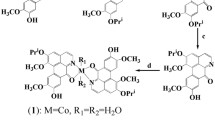Abstract
We previously developed a chelating ligand, 1-(2-hydroxy-3-methoxybenzaldehyde)-4-aminosalicylhydrazone (HMB–ASH), which can chelate Fe(III) to form a complex. The HMB–ASH–Fe(III) complex exhibits a dose-dependent anti-proliferative effect in HepG2 cells, whereas the ligand, HMB–ASH, and Fe(III) alone had no considerable effect. The HMB–ASH–Fe(III) complex was composed of Fe(III):HMB–ASH (1:2), as determined by high-performance liquid chromatography with high-resolution mass spectrometry. The IC50 value was approximately 20 μM, which was comparable to those of the anti-cancer drugs oxaliplatin (OXP) and etoposide (ETP) under the same conditions. Similar to OXP and ETP, HMB–ASH–Fe(III) induced apoptosis in HepG2 cells, as revealed by terminal deoxynucleotidyl transferase fluorescein-12-dUTP nick end labeling assay.








Similar content being viewed by others
References
Alexandrova RI, Zhivkova T, Alexandrov M, Miloshev G, Georgieva M, Pantcheva IN, Mitewa MI (2012) Cytostatic and cytotoxic properties of monensic acid and its biometal(II) complexes against human tumor/non-tumor cell lines. Cent Eur J Chem 10:1464–1474. doi:10.2478/s11532-012-0071-9
Chen Y, Qin MY, Wang L, Chao H, Ji LN, Xu AL (2013) A ruthenium(II) beta-carboline complex induced p53-mediated apoptosis in cancer cells. Biochimie 95:2050–2059. doi:10.1016/j.biochi.2013.07.016
Dyakova L, Culita DC, Marinescu G, Alexandrov M, Kalfin R, Patron L, Alexandrova R (2014) Metal Zn(II), Cu(II), Ni(II) complexes of ursodeoxycholic acid as putative anticancer agents. Biotechnol Biotechnol Equip 28:543–551. doi:10.1080/13102818.2014.927973
Farag AM, Guan TS, Osman H, Majid A, Iqbal MA, Ahamed MBK (2013) Synthesis of metal(II) M = Cu, Mn, Zn Schiff base complexes and their Pro-apoptotic activity in liver tumor cells via caspase activation. Med Chem Res 22:4727–4736. doi:10.1007/s00044-013-0482-y
Genc Z, Selcuk S, Sandal S, Colak N, Keser S, Sekerci M, Karatepe M (2014) Spectroscopic, antiproliferative and antiradical properties of Cu(II), Ni(II), and Zn(II) complexes with amino acid based Schiff bases. Med Chem Res 23:2476–2485. doi:10.1007/s00044-013-0826-7
Hou MH, Wang AHJ (2005) Mithramycin forms a stable dimeric complex by chelating with Fe(II): dNA-interacting characteristics, cellular permeation and cytotoxicity. Nucleic Acids Res 33:1352–1361. doi:10.1093/nar/gki276
Hsu C, Kuo C, Chuang S, Hou M (2013) Elucidation of the DNA-interacting properties and anticancer activity of a Ni(II)-coordinated mithramycin dimer complex. Biometals 26:1–12. doi:10.1007/s10534-012-9589-8
Huang KB, Chen ZF, Liu YC, Li ZQ, Wei JH, Wang M, Zhang GH, Liang H (2013) Platinum(II) complexes with mono-aminophosphonate ester targeting group that induce apoptosis through G1 cell-cycle arrest: synthesis, crystal structure and antitumour activity. Eur J Med Chem 63:76–84. doi:10.1016/j.ejmech.2013.01.055
Kimura J, Yamada H, Ogura H, Yajima T, Fukushima T (2009a) Development of a fluorescent chelating ligand for gallium ion having a quinazoline structure with two Schiff base moieties. Anal Chim Acta 635:207–213. doi:10.1016/j.aca.2009.01.008
Kimura J, Yamada H, Yajima T, Fukushima T (2009b) Enhancement effect of some phosphorylated compounds on fluorescence of quinazoline-based chelating ligand complexed with gallium ion. J Lumin 129:1362–1365. doi:10.1016/j.jlumin.2009.07.005
Kovacevic Z, Kalinowski DS, Lovejoy DB, Yu Y, Rahmanto YS, Sharpe PC, Bernhardt PV, Richardson DR (2011) The medicinal chemistry of novel iron chelators for the treatment of cancer. Curr Top Med Chem 11:483–499. doi:10.2174/156802611794785190
Mahmudov KT, da Silva M, Kopylovich MN, Fernandes AR, Silva A, Mizar A, Pombeiro AJL (2014) Di- and tri-organotin(IV) complexes of arylhydrazones of methylene active compounds and their antiproliferative activity. J Organomet Chem 760:67–73. doi:10.1016/j.jorganchem.2013.12.019
Nath M, Vats M, Roy P (2014) Design, spectral characterization, anti-tumor and anti-inflammatory activity of triorganotin(IV) hydroxycarboxylates, apoptosis inducers: in vitro assessment of induction of apoptosis by enzyme, DNA-fragmentation, acridine orange and comet assays. Inorg Chim Acta 423:70–82. doi:10.1016/j.ica.2014.02.034
Roy P, Dhara K, Manassero M, Ratha J, Banerjee P (2007) Selective fluorescence zinc ion sensing and binding behavior of 4-methyl-2,6-bis(((phenylmethyl)imino)methyl)phenol: biological application. Inorg Chem 46:6405–6412. doi:10.1021/ic700420w
Rubino S, Di Stefano V, Attanzio A, Tesoriere L, Girasolo MA, Nicolo F, Bruno G, Orecchio S, Stocco GC (2014) Synthesis, spectroscopic characterization and antiproliferative activity of two platinum(II) complexes containing N-donor heterocycles. Inorg Chim Acta 418:112–118. doi:10.1016/j.ica.2014.03.028
Tan J, Wang BC, Zhu LC (2009) DNA binding, cytotoxicity, apoptotic inducing activity, and molecular modeling study of quercetin zinc(II) complex. Bioorganic Med Chem 17:614–620. doi:10.1016/j.bmc.2008.11.063
Thati B, Noble A, Creaven BS, Walsh M, Kavanagh K, Egan DA (2007) Apoptotic cell death: a possible key event in mediating the in vitro anti-proliferative effect of a novel copper(II) complex, Cu(4-Mecdoa) (phen)(2) (phen = phenanthroline, 4-Mecdoa = 4-methylcoumarin-6, 7-dioxactetate), in human malignant cancer cells. Eur J Pharmacol 569:16–28. doi:10.1016/j.ejphar.2007.04.064
Yamada H, Shirai A, Kato K, Kimura J, Ichiba H, Yajima T, Fukushima T (2010) Development of a quinazoline-based chelating ligand for zinc ion and its application to validation of a zinc-Ion-coordinated compound. Chem Pharm Bull 58:875–878
Yamada H, Kojo M, Nakahara T, Murakami K, Kakima T, Ichiba H, Yajima T, Fukushima T (2012) Development of a fluorescent chelating ligand for scandium ion having a Schiff base moiety. Spectrochim Acta Part A 90:72–77. doi:10.1016/j.saa.2012.01.014
Yu Y, Gutierrez E, Kovacevic Z, Saletta F, Obeidy P, Rahmanto YS, Richardson DR (2012) Iron chelators for the treatment of cancer. Curr Med Chem 19:2689–2702
Acknowledgments
The authors thank Drs. Iwasa and Iizuka, Toho University for their valuable discussions on this study, and Mr. T. Abe, T. Sakamoto, and Miss M. Hanaoka for their technical assistance.
Author information
Authors and Affiliations
Corresponding author
Electronic supplementary material
Figure S1. Anti-proliferative effects of isolated powder including HMB–ASH–Fe(III) complexes in HepG2 cells (mean ± S.E. [n = 3]).
Rights and permissions
About this article
Cite this article
Fukushima, T., Taniguchi, E., Yamada, H. et al. Anti-proliferative effect of Fe(III) complexed with 1-(2-hydroxy-3-methoxybenzaldehyde)-4-aminosalicylhydrazone in HepG2 cells. Biometals 28, 669–677 (2015). https://doi.org/10.1007/s10534-015-9852-x
Received:
Accepted:
Published:
Issue Date:
DOI: https://doi.org/10.1007/s10534-015-9852-x




